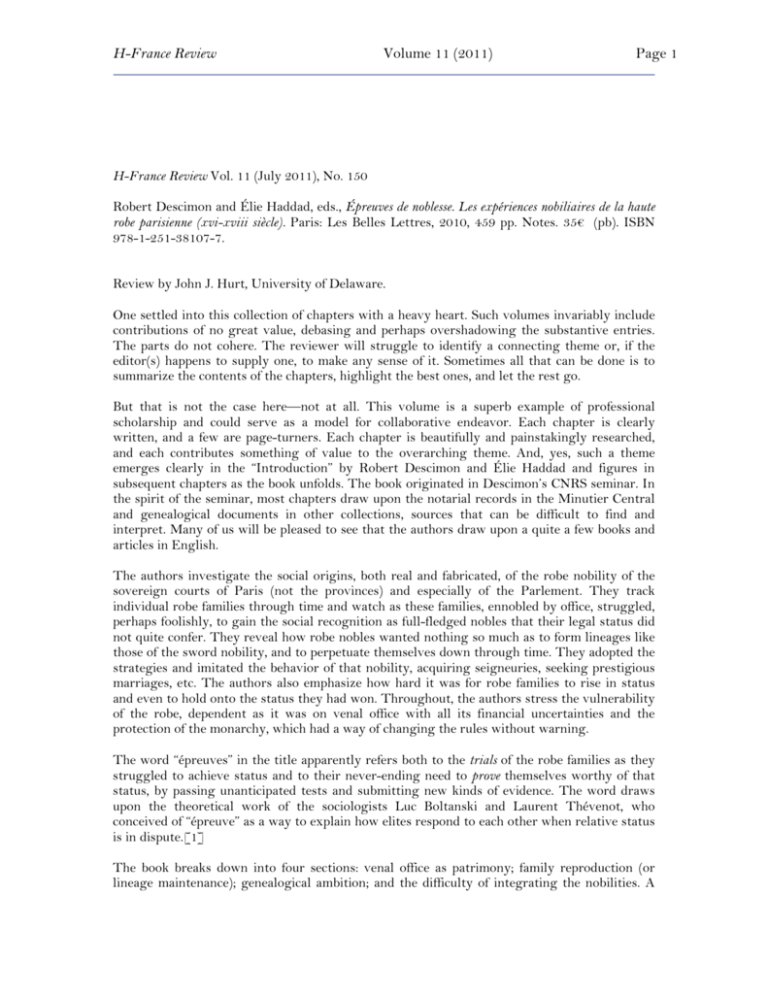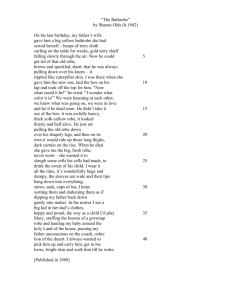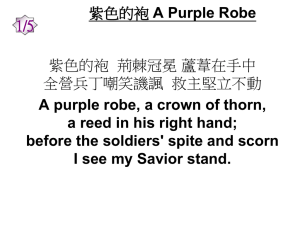
H-France Review
Volume 11 (2011)
Page 1
H-France Review Vol. 11 (July 2011), No. 150
Robert Descimon and Élie Haddad, eds., Épreuves de noblesse. Les expériences nobiliaires de la haute
robe parisienne (xvi-xviii siècle). Paris: Les Belles Lettres, 2010, 459 pp. Notes. 35€ (pb). ISBN
978-1-251-38107-7.
Review by John J. Hurt, University of Delaware.
One settled into this collection of chapters with a heavy heart. Such volumes invariably include
contributions of no great value, debasing and perhaps overshadowing the substantive entries.
The parts do not cohere. The reviewer will struggle to identify a connecting theme or, if the
editor(s) happens to supply one, to make any sense of it. Sometimes all that can be done is to
summarize the contents of the chapters, highlight the best ones, and let the rest go.
But that is not the case here—not at all. This volume is a superb example of professional
scholarship and could serve as a model for collaborative endeavor. Each chapter is clearly
written, and a few are page-turners. Each chapter is beautifully and painstakingly researched,
and each contributes something of value to the overarching theme. And, yes, such a theme
emerges clearly in the “Introduction” by Robert Descimon and Élie Haddad and figures in
subsequent chapters as the book unfolds. The book originated in Descimon’s CNRS seminar. In
the spirit of the seminar, most chapters draw upon the notarial records in the Minutier Central
and genealogical documents in other collections, sources that can be difficult to find and
interpret. Many of us will be pleased to see that the authors draw upon a quite a few books and
articles in English.
The authors investigate the social origins, both real and fabricated, of the robe nobility of the
sovereign courts of Paris (not the provinces) and especially of the Parlement. They track
individual robe families through time and watch as these families, ennobled by office, struggled,
perhaps foolishly, to gain the social recognition as full-fledged nobles that their legal status did
not quite confer. They reveal how robe nobles wanted nothing so much as to form lineages like
those of the sword nobility, and to perpetuate themselves down through time. They adopted the
strategies and imitated the behavior of that nobility, acquiring seigneuries, seeking prestigious
marriages, etc. The authors also emphasize how hard it was for robe families to rise in status
and even to hold onto the status they had won. Throughout, the authors stress the vulnerability
of the robe, dependent as it was on venal office with all its financial uncertainties and the
protection of the monarchy, which had a way of changing the rules without warning.
The word “épreuves” in the title apparently refers both to the trials of the robe families as they
struggled to achieve status and to their never-ending need to prove themselves worthy of that
status, by passing unanticipated tests and submitting new kinds of evidence. The word draws
upon the theoretical work of the sociologists Luc Boltanski and Laurent Thévenot, who
conceived of “épreuve” as a way to explain how elites respond to each other when relative status
is in dispute.[1]
The book breaks down into four sections: venal office as patrimony; family reproduction (or
lineage maintenance); genealogical ambition; and the difficulty of integrating the nobilities. A
H-France Review
Volume 11 (2011)
Page 2
learned introduction precedes each section, and a conclusion by Descimon offers some
interesting thoughts on lineage, heredity, and the transmission of property.
Venal office, one of Descimon’s main interests, assumes its full importance in this collection, and
the first two articles treat that not altogether venerable institution. As shown by Descimon and
Simone Geoffroy-Poisson, the Paris courts helped the robe along by re-interpreting the
customary law of Paris, which contained the principle of equality in the transmission of
hereditary property. Starting in the early 1500s, decrees of Parlement and subordinate tribunals
undermined this principle and favored the husband over the wife and the oldest son over his
siblings, in imitation of the nobility. This was especially true for the inheritance of venal office.
This new jurisprudence made sure that offices would stay with the male side of the family and
not revert to the spouse even if her resources had made it possible to acquire the office, a
“profound change in social practice” (p. 55). The authors draw upon the work of Sarah Hanley
here. Thus, venal office became the foundation of the robe patrimony, like a fief, and enhanced
the formation of lineage. But the investment did not prove as secure as had been hoped.
Rightly, in my opinion, Descimon and Martine Benninni stress the importance of the rise and
fall of office prices from the early to the late 1600s and beyond. When Henry IV created the
paulette in 1604, he stimulated demand for offices and extraordinary gains in office prices, all
thoroughly researched and charted on four graphs (keep a magnifying glass handy). In that
period, the robe flourished. But in 1665 Colbert dealt office-holders a blow with his effort to
lower prices, and other financial problems for venal office accumulated towards the end of the
reign of Louis XIV. By 1715, the decline, or even collapse, of prices (also shown on the graphs)
compromised the patrimonial interests of the robe and subjected families to “épreuves sociales”
(p. 44), revising the unwritten rules of the game.[2]
A century later the royal administration changed the rules again when it introduced the
Maupeou reforms of 1771-1774. These reforms abolished venality and therefore suppressed
offices, on the promise of an unreliable reimbursement. Éric Viguier and Mathieu Marraud
assess the ideological and social turmoil that Chancellor Maupeou unleashed. Pamphlet warfare
ensued, with representatives of the Parlement thunderously denouncing the reforms as arbitrary
and a huge step towards despotism. Since office prices had not recovered much from the Louis
XIV era, one may wonder if the magistrates were overreacting. The authors answer this
question by showing that venal offices, whatever their current value, were so burdened with
debt based on earlier values that creditors, even family members, were much to be feared. Thus,
the economic fragility and vulnerability of robe families get renewed emphasis.
The word fragility reappears in the next section when the authors shift to the problem of
establishing and maintaining a family lineage. The latter task seems to have been harder than
the former. Thus the Spifame family, having risen in the financial world to acquire a chateau and
a domain, never established itself in the sovereign courts, the logical next step. Instead, the
family tore itself apart when younger heirs sought a greater share of inherited properties in one
lawsuit after another. All this is followed in great detail, based on extensive notarial research
(Pavel Ouvarov, Élodie Milles, and Robert Descimon). Similarly, the descendants of Michel de
L’Hospital, chancellor under Charles IX, fought for decades with hair-splitting judicial
creativity over a compromised, indebted succession, and no one emerged a winner (Patrice
Alex).
In a fascinating but different contribution, Claire Chatelain shows how Marie Michelle Bernard
triumphed in the courts over her allegedly abusive husband, Jean-Baptiste Pommereu, a master
of requests and disgraced intendant of Champagne. It turns out that Marie’s contention that she
was a battered, insulted spouse, although widely publicized in numerous literary factums,
H-France Review
Volume 11 (2011)
Page 3
camouflaged her effort to control the assets she brought to the marriage community in favor of
her sons and not her unsatisfactory mate. Her judicial victory, although well deserved, took
something away from the principle of male/spousal control upon which lineages established
themselves.
The third section, devoted to genealogical evasions and deceptions, will be of great interest.
Here, as in the fourth section, the authors follow the estimable Jean Meyer, who argued that the
“reformation” (or verification) of noble status under Louis XIV redefined the nobility as those
families who could “prove” their rank according to new rules laid down by the government.
These rules demanded that persons claiming noble status produce conclusive legal documents—
titles, exemptions, testaments showing mode of inheritance, and so on.[3] Such standards
necessarily redounded to the advantage of those who had been nobles the longest; and that did
not include the robe. As Madame de Sévigné wrote in 1668, “Il a fallu montrer notre noblesse en
Bretagne; et ceux qui ont le plus, ont pris plaisir de se servir de cette occasion pour étaler leur
merchandise.” She then rattled off evidence of 350 years of noble descent, backed up with
marriage contracts from father to son.[4]
The sovereign court judges wanted to argue that their family ascendancy had begun long before
they became magistrates, thus making them worthy of assimilation into the older nobility. Such
claims could not stand up under close genealogical scrutiny. Chapters by Martine Bennini on
the Bragelongne and Camille Le Fauconier and Élie Haddad on the Sublet de Noyers illustrate
this point in different ways.
Pierre de Bragelongne, a Parisian who became a président des enquêtes at the Parlement of
Rennes, published a family genealogy so full of improbabilities that Charles d’Hozier, the royal
genealogist, denounced it as a fraud. Bragelongne probably intended to solidify his prestige
among the more successful branches of his family and to elevate the lineage as a whole. He had
set himself quite a task, given the family’s recent mercantile origins and its late arrival in the
robe. Undaunted, he imagined an ancient family chateau in Burgundy and phantom Bragelongne
seigneurs associated with it. Small wonder that d’Hozier marked up this work of fiction with a
critical hand. The genealogy does show the lengths to which robe families would go, now that
longevity had become a criterion.
The Sublet de Noyers suffered a different fate. After the successful career of François Sublet de
Noyers (1588-1645), secretary of state for war and superintendant of buildings under Louis
XIII, the family withdrew to Normandy and lived unostentatiously for decades. But in 1755 a
certain Regnault slandered the family when he published the altogether fictitious account of a
second marriage allegedly contracted by François with a young girl of humble birth named
Geneva. When she was ten years old, Geneva became the femme de chambre to the spouse of
François and married her master shortly after her mistress died, adding to the scandal. When
Geneva died years later, she was said to have left 800,000 livres in still unrecovered coin to the
Jesuits, more untruths. Apparently Regnault intended his pamphlet, a parody of genealogical
scholarship, to damage the Sublet in some lawsuit or other. The whole bizarre episode shows
the felt sensitivities and insecurities of robe families on the subject of their genealogical past.
In the fourth section, the authors turn to the topic of social integration between the robe and
sword nobilities, a subject taken up almost seventy years ago in the pioneering, brilliant but
flawed study by Franklin Ford.[5] Perhaps unsurprisingly, they find that such social fusion met
with obstructions and unexpected problems, none to the advantage of the robe families.
Assimilation was more difficult than Ford believed. Élie Haddad examines the Mesgrigny
family, which in the late 1500s established itself in Paris in two branches. The older branch rose
through offices, including magistracies in the Parlements of Aix (first president), Rouen
H-France Review
Volume 11 (2011)
Page 4
(président à mortier), and Paris (councilor). It acquired seigneuries and married brides of the old
nobility, into which it managed to assimilate, an apparent success story. But this branch died out
in 1732; and the family destiny rested with the cadet branch. The cadets also followed the career
paths of established nobles, obtaining seigneuries, adopting marital strategies, and becoming
bishops and army officers. But it took a lot of collective family discipline to sustain all these
efforts on behalf of the lineage; and in the 1700s the Mesgrigny succumbed to a shortage of
heirs and inadequate resources. A prestigious marriage, which would have restored their
fortunes, remained out of reach. Haddad contends that the new genealogical standards
privileging longevity of noble status hobbled families like the Mesgrigny. Offices they could buy
and hold, robe nobility they could secure, seigneuries they could obtain and even posts in the
church and army. But little or nothing could be done to give them a credible family history
stretching back into distant centuries. They owed their setback in part to royal policies
established under Colbert and Louis XIV.
Mathieu Marraud and Nicolas Lyon-Caen reveal yet another way in which families attempting
to rise through office faced difficulties and setbacks. In a highly original contribution, they
follow two successful merchant families—the Coustard of Angers and the Deberny of Amiens—
who placed sons in the sovereign courts of Paris as the reign of Louis XIV approached its end.
They needed a lot of money, but they had it. Coustard spent some 400,000 livres acquiring an
office in Parlement for his son and marrying his two daughters into the robe nobility; and
Deberny used about as much money for similar purposes. But Coustard found that his
considerable wealth could not buy as much status as he wanted. He could afford the dowries it
took to marry his daughters suitably, but his son had to settle for a bride of lesser status.
Wealth took one only so far. Both fathers had to work shrewdly to shed their commercial
holdings, so lacking in prestige, the better to assist their sons. The robe nobles, as it turns out,
adhered to snobbish standards too. Unfortunately, the Coustard story had an unhappy ending.
Having shed their commercial wealth, the Coustard could not maintain such status as they had
acquired. Coustard’s councilor son lost everything when he committed to an excessive dowry in
order to marry his daughter into a truly distinguished robe family. The latter insisted upon
being paid, to the sou. New robe families, like the more established ones, found climbing the
ladder more fraught than they could have anticipated.
Finally, Laurence Croq scrutinizes the Marais district of eighteenth-century Paris, a preferred
quartier for magistrates in the Parlement and the Chambre des Comptes. His goal is to
determine how their lifestyle and behaviors compared with those of the nobility of the
Enlightenment. It turns out that the Marais robe resisted innovation and change just as much
as the more progressive sword nobles thought that they did. The magistrates did not buy very
much in the way of consumer goods, not paintings or new clothes and certainly not new books.
They did not care for Enlightenment authors and knew hardly any of them. They kept to
themselves socially, nurturing professional friendships and alliances within their enclave. Their
conversation addressed different topics from those in the aristocratic salons. Resenting the
Maupeou reforms, they distanced themselves from the royal administration. Although the
author does not say so, it seems as though this upper robe, given its recent, disappointing social
history, had altogether abandoned any aspirations towards social rise. It had become isolated,
thrown back upon itself.
These chapters, being so thoroughly researched and persuasively argued, leave the reviewer
with few grounds for complaint. One point, however, should be made. One could estimate that
at least two thousand magistrates passed through the Parlement of Paris alone during the
centuries under review. Obviously, the contributors to this volume have dealt with only a few of
them. François Bluche, who did not undertake this depth of analysis, was able to cast his net
more widely in his study of the eighteenth-century Parlement.[6] Descimon and his
H-France Review
Volume 11 (2011)
Page 5
collaborators, in their emphasis upon difficulties and trials, do not treat the upper layers of the
sovereign court judges. If one examined the family histories of the présidents à mortier or the first
presidents—such families as the Lamoignon, Harlay, Potier de Novion, Le Pelletier, and
others—the picture would surely brighten.
NOTES
[1] Luc Boltanski and Laurent Thévenot, De la justification. Les économies de la grandeur (Paris:
Gallimard, 1991), pp. 168-174 (“L’épreuve”).
[2] Here the authors might have profited from Mark Potter’s interesting argument about defacto royal protection of venal office as patrimonial property, which has broad implications:
Corps and Clienteles. Public Finance and Political Change in France, 1688-1715 (Aldershot,
Hampshire: Ashgate Publishing, 2003), pp. 28-48. However, Potter underestimated the financial
damage office holders suffered in this period and beyond.
[3] Jean Meyer, La noblesse bretonne au XVIII siècle, 2 vols (Paris: École Pratique des Hautes
Études, 1966).
[4] Madame de Sévigné to comte de Bussy-Rabutin, Paris, 4 December 1668, in Madame de
Sévigné, Lettres, ed. Gérard-Gailly (Paris: La Pléiade, 1953-1960), 3 volumes, I, 160.
[5] Franklin L. Ford, Robe and Sword. The Regrouping of the French Aristocracy after Louis XIV
(Cambridge, Mass.: Harvard University, 1953).
[6] François Bluche, Les magistrates du Parlement de Paris au XVIII siècle (Paris: Les Belles
Lettres, 1960).
John J. Hurt
University of Delaware
hurt@udel.edu
Copyright © 2011 by the Society for French Historical Studies, all rights reserved. The Society
for French Historical Studies permits the electronic distribution of individual reviews for
nonprofit educational purposes, provided that full and accurate credit is given to the author, the
date of publication, and the location of the review on the H-France website. The Society for
French Historical Studies reserves the right to withdraw the license for
edistribution/republication of individual reviews at any time and for any specific case. Neither
bulk redistribution/ republication in electronic form of more than five percent of the contents of
H-France Review nor re-publication of any amount in print form will be permitted without
permission. For any other proposed uses, contact the Editor-in-Chief of H-France. The views
posted on H-France Review are not necessarily the views of the Society for French Historical
Studies.
ISSN 1553-9172








